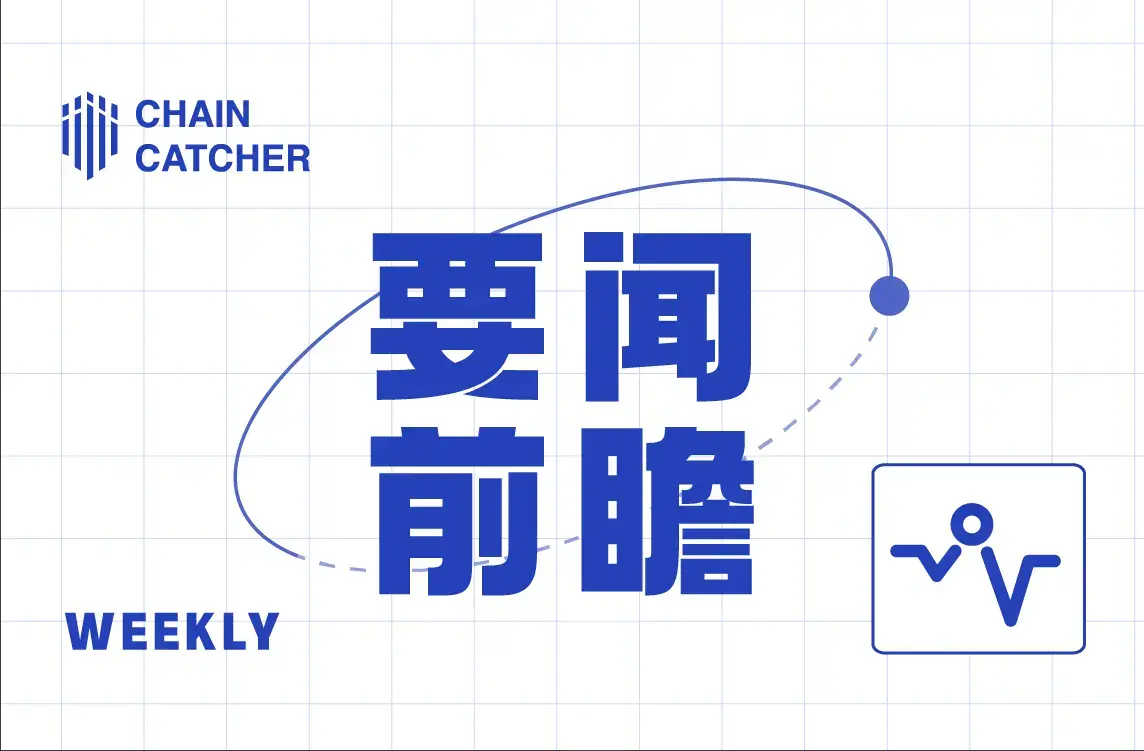Terra Eco New Products Overview: Understand the Cross-Chain Gun Pool Nexus Protocol in Three Minutes
Written by: Li Ke
With the recent completion of the Columbus-5 upgrade and activation of IBC functionality on the Terra blockchain, a large number of Terra ecosystem projects are about to launch, and various decentralized applications are beginning to emerge. The newly launched Nexus Protocol is a comprehensive yield farming pool project born in the Terra ecosystem. Through Nexus, farming yields can be maximized while avoiding the risk of liquidation of staked funds.
According to the Nexus team, the protocol eliminates the complexity of DeFi farming by deploying automated strategies, providing users with simple, optimized, and sustainable yields.
To maximize yields, Nexus has established multiple yield strategies and incentivizes community members to develop better yield strategies through a community fund to continuously improve the yield of the farming pool.
Nexus Protocol is first launched on the Terra blockchain. According to the project's development roadmap, as Terra cross-chains to other public chains through Cosmos IBC, the Nexus farming pool will eventually cover other public chains, becoming a comprehensive yield aggregator and liquidation protection platform in the cross-chain space.
Nexus plans to have at least three farming pools, with the Anchor farming pool already online, while the Mirror farming pool and EthNexus are under development, expected to launch in the first quarter of 2022.
What is a Farming Pool?
To better understand Nexus Protocol, let's start with the concept of a farming pool. The concept of a farming pool originated from the Yearn project. A farming pool is essentially a pooled mining fund that maximizes yields. Farming pool strategies typically involve multiple actions to achieve yield maximization, which may include providing collateral and borrowing other assets (such as stablecoins), providing liquidity and collecting trading fees, or mining other tokens and selling them for profit.
Liquidity mining is a time-consuming and costly activity. Therefore, if you are unwilling to spend a long time searching for the best mining yield opportunities, unwilling to spend hundreds of dollars in gas fees to transfer funds, and unwilling to constantly monitor your collateral ratio, the best approach is to rely on a farming pool. The advantage of a farming pool is that it can automate liquidity mining, and its strategies can protect user funds from liquidation risks.
Nexus's Anchor Farming Pool
The first farming pool of Nexus Protocol is deployed on Anchor Protocol.
Anchor Protocol is a new fixed-rate lending protocol based on the Terra ecosystem. Unlike traditional DeFi lending projects like Compound and AAVE, Anchor provides users with stable interest rate yields. In the Anchor Protocol system, depositors and borrowers can achieve a win-win situation: depositors can earn around 20% stable interest rate yields by depositing UST into the pool, while borrowers can collateralize ETH and LUNA to borrow Terra stablecoin UST at low or even negative interest rates. How is this achieved?
Anchor depositors' interest earnings consist of two parts: one is the UST borrowing interest paid by borrowers, and the other part comes from the staking or mining rewards earned from the collateralized crypto assets of lenders.
Anchor lenders will also receive lower borrowing rates, even negative rates, because when they collateralize ETH or LUNA for loans, they can receive ANC rewards from the Anchor protocol.
Anchor distributes the mining rewards from collateralized assets to borrowers and lenders and dynamically adjusts to achieve the Anchor Rate.
Because Anchor can provide users with higher stable yields, Nexus further maximizes yields through a series of strategy deployments based on Anchor.
Anyone who has operated DeFi protocols knows the complexity of staking, exchanging, and withdrawing yields, as well as the high gas fees involved. What the Nexus farming pool aims to do is automate a series of operations involved in farming yields from Anchor, reducing users' time costs and operational thresholds, while saving gas fees in a unified operation.
In addition, on Nexus, users do not need to closely monitor their LTV (Loan-to-Value) ratio in Anchor to ensure their funds are not liquidated. Nexus can ensure that user funds are not liquidated by setting programmed strategies that provide the highest possible LTV ratio.
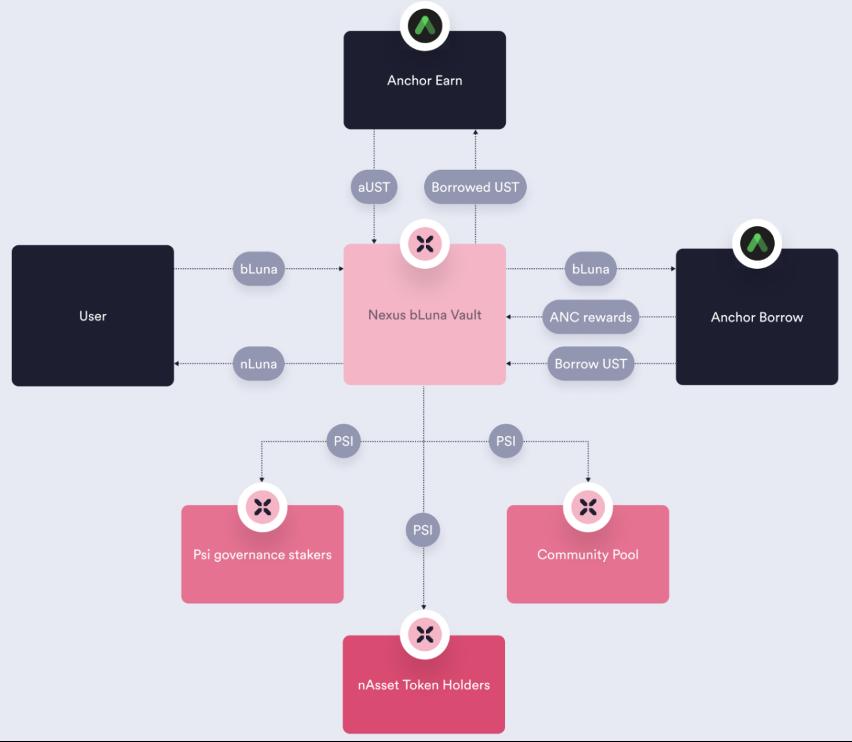
Specifically, first, users deposit bAsset assets (bLuna or bETH) into the Nexus Anchor farming pool and receive nAsset (nLuna or nETH);
Second, the farming pool automatically stakes the bAsset in the pool to Anchor to borrow UST and earn ANC rewards;
Next, the farming pool deposits the borrowed UST into the Anchor deposit pool to earn UST borrowing interest through mining. The earnings obtained by the farming pool will be distributed to nAsset asset holders, Psi governance stakers, and the community pool in the form of the Psi token. Through this series of combined strategy operations, the farming yields on Anchor can be maximized.
Note: bAssets are liquidity tokens for staked assets in PoS blockchains, allowing stakers to gain liquidity for their staked assets, thus enabling the locked value of staked assets to participate in DeFi activities such as Anchor lending.
The bAsset token has redemption rights for the underlying staked assets, and its staking rewards are also distributed to bAsset holders. By tokenizing staked assets, liquidity is provided to staked assets, revitalizing the staked assets and allowing for flexible distribution of rewards earned from the staked assets.
In the Nexus Anchor farming pool, the currently allowed bAssets for users to deposit are bLuna and bETH. bLuna is the liquidity token for the Terra public chain token Luna after PoS staking. bETH is the liquidity token for Ethereum 2.0 staking, which can exist on both Ethereum and Terra chains (further explained in the third farming pool EthNexus below).
As of November 22, the locked value of bLuna in the Nexus Anchor farming pool is 35 million UST, with an APR yield of approximately 8.61%; the locked value of bEth is 23 million UST, with an APR yield of approximately 8.44%.
Nexus's Mirror Farming Pool
The second farming pool of the Nexus protocol is planned to be deployed on Mirror Protocol. The team expects that through a series of strategy deployments, the Mirror farming pool can achieve a yield of around 40%.
First, let’s briefly introduce Mirror Protocol. This is a synthetic asset minting and trading platform within the Terra ecosystem, focusing on bringing US stocks into DeFi in the form of synthetic assets, allowing global investors to easily purchase US stocks on Mirror. In addition to US stocks, Mirror can also track the prices of futures, funds, and other traditional financial assets, aiming to bring global assets onto the blockchain. Based on Terra's cross-chain attributes, Mirror Protocol will also introduce synthetic assets to other public chains such as Ethereum and BSC.
Mirror Protocol mints stocks into synthetic tokens called mAssets (Mirrored Assets) by staking UST. Currently, stocks like Apple, Tesla, Microsoft, and Twitter have been minted as tokens. The minted and traded US stock tokens do not represent actual ownership of the stocks in reality; they merely anchor the price of the asset, similar to the issuance of DAI, and will not generate dividends. To keep the token price aligned with US stock prices, mAssets will use oracles (Band Protocol) to track and update stock prices every six seconds.
Currently, the main functions of the Mirror platform include trading mAssets, staking UST to mint mAssets, providing mAssets-UST LP for liquidity mining, and staking other assets to short mAssets, with the latter two transactions earning MIR token rewards.
Like the Anchor farming pool, Nexus plans to provide a one-click solution, allowing users to easily mine and withdraw yields on the Mirror protocol without frequent staking, shorting, or going long.
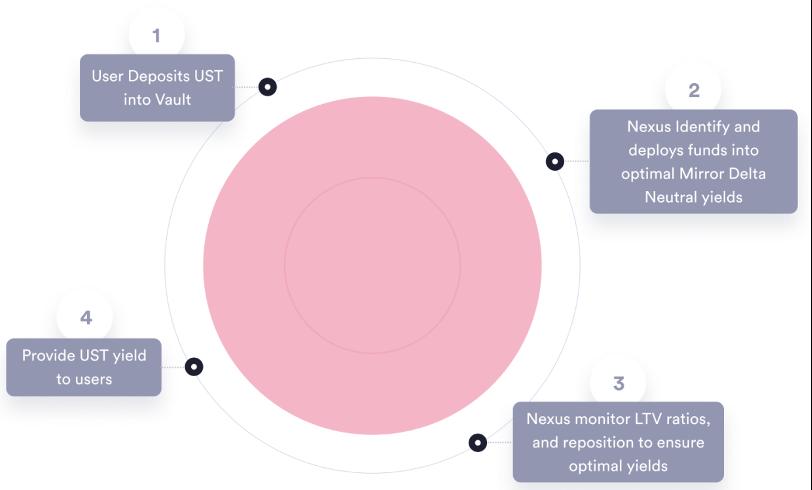
Specifically, the yield strategy used by the Mirror farming pool is as follows:
- Users deposit UST into the Mirror farming pool;
- A portion of UST is deposited into Anchor to obtain aUST;
- aUST is staked in Mirror to borrow mAssets;
- The remaining UST and the borrowed mAssets together form an mAssets-UST LP for liquidity mining to earn yields.
The strategy can also collateralize UST, aUST, or other mAsset assets to short mAssets for mining yields, while simultaneously purchasing mAssets to hedge risks.
EthNexus Farming Pool
The aforementioned Nexus Anchor farming pool only accepts bLuna and bETH as collateral assets. So how can ETH holders participate in Nexus's farming pools?
In the future, the Nexus team hopes to further establish the EthNexus farming pool around ETH, planning to launch this farming pool on Ethereum in the first quarter of 2022. This farming pool will provide ETH holders with higher yield returns compared to other platforms and offer the simplest possible operations.

The specific strategy implementation process for EthNexus is relatively complex, but there are only two things users need to do: one is to deposit assets, and the second is to withdraw yields, while the complex strategy deployments can be handled by the farming pool.
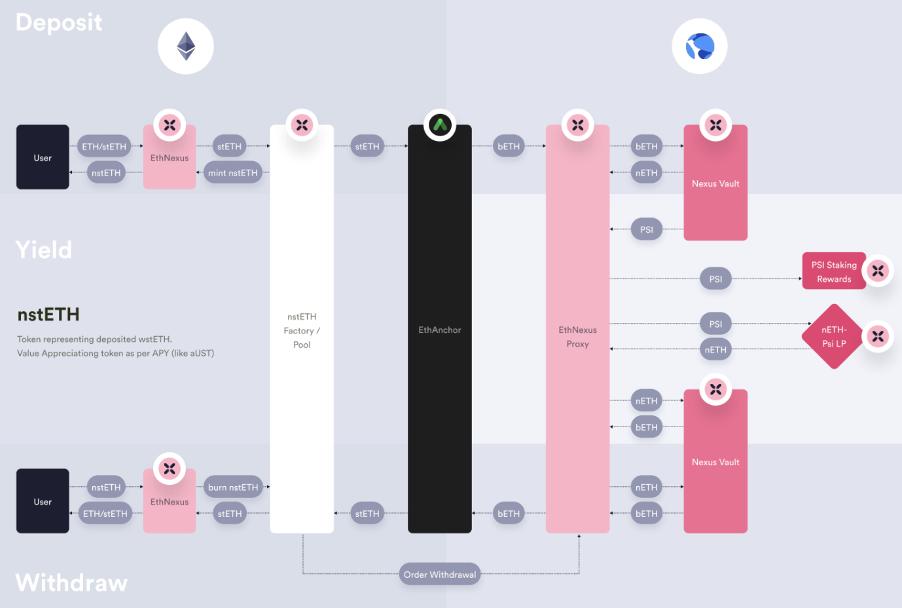
In fact, compared to the Anchor farming pool, EthNexus mainly adds an automatic operation to convert ETH into bETH, and the final yield is also withdrawn in ETH (the Anchor farming pool yields are distributed in the form of Psi).
Specifically, in the first step, after users deposit ETH into EthNexus, the farming pool mints stETH from ETH through Lido, then converts the stETH on Ethereum into bETH through Lido, and crosses over to Terra. Next, it follows the same operational logic as the Anchor farming pool, first staking nETH in Anchor to borrow UST and earn ANC rewards, and then depositing the borrowed UST into Anchor to enjoy interest yields.
When users unstake, the farming pool will reverse the above first step, ultimately returning the user's ETH while converting the obtained yields into ETH to distribute to the user, thus achieving the effect of allowing users to deposit ETH and earn ETH.
How to Ensure the Safety of Strategies?
To safely manage LTV and prevent unexpected situations, the Nexus farming pool has set up three safety modes based on different scenarios. The complete version of the Nexus farming pool will run optimal mode, safe mode, and emergency mode simultaneously in the future.

In optimal mode, Nexus's price oracle updates price data every 15 seconds, instead of every 30 seconds as in Anchor, allowing Nexus to know the exact price of collateral assets slightly earlier than Anchor Protocol. Through this leading logic, Nexus can maintain an ideal LTV level without putting assets at liquidation risk.
In safe mode, if Nexus's price oracle fails, the Nexus protocol will automatically change its LTV management logic based on safe mode and use Anchor's price oracle. However, this means Nexus will not have priority over Anchor's price oracle, so Nexus must closely monitor the target LTV level to ensure the safety of users' collateral positions.
In emergency mode, if all anchored price oracles fail, the Nexus protocol will automatically change its LTV management logic and immediately reduce the target LTV by half. Once the Nexus protocol detects that Anchor's price oracle has resumed normal functionality, emergency mode will be disabled, and safe mode will be restored.
Currently, Nexus has activated safe mode and emergency mode, while optimal mode is under development and is expected to be released in the fourth quarter.
Farming Pool Strategy Incentive Program
To find the optimal farming pool strategies and incentivize strategists to research and develop better yield strategies, Nexus rewards community members through a community fund for developing and deploying better farming pool strategies. The community fund accounts for 10% of the initial token supply and will increase with the growth of protocol tax revenue.
In Nexus's strategy incentive program, there are three roles, and anyone can participate.

Strategy Collectors: Responsible for gathering high-return yield strategies in the DeFi ecosystem, with a limited number of positions for strategy collectors.
Core Strategists: Responsible for identifying the most promising and potential farming pools, selected by strategy collectors and Psi governors. Core strategist positions are term-based and can be re-elected, ensuring that strategies are continuously updated.
Nexus Governors: Stakers of Psi tokens have the right to elect core strategists and strategy collectors.
Bond Issuance Plan
Inspired by projects like OHM, Nexus has recently updated some project roadmaps, believing that creating its own liquidity will be crucial in the future, thus introducing a bond issuance plan.
From the fourth quarter of this year to the beginning of the first quarter of next year, Nexus will prioritize the development of the bond issuance plan, which will allow users to purchase Psi at a discount using assets and claim discounted Psi after a certain lock-up period. Through the bond plan, the Nexus community fund will begin to establish its own liquidity reserves.
By establishing its own liquidity, Nexus will no longer need to use Psi to incentivize liquidity providers in the Psi/UST pool. This can significantly reduce the inflationary pressure on Psi. Furthermore, the issuance of bonds will provide more funding for the Nexus DAO community, allowing for the development of more strategies and tools for the Terra community and beyond.
Token Inflation Strategy
Nexus is also reconsidering the issue of token inflation, as it is a matter of the project's sustainability. In this regard, the Nexus team stated that it will reference a relatively interesting project, Temple DAO.
The problem TempleDAO aims to solve is that traditional project token design and distribution are fixed. When buyers' funds continuously enter the protocol, prices rise, and early investors profit. However, if prices rise too quickly, holders will sell off, and when prices begin to fall, everyone starts to sell, causing a significant drop in token prices. Moreover, as tokens are continuously released and diluted, inflationary pressure increases, leading to further price declines.
Unlike most protocols, to maintain stable and sustainable growth in token prices, TempleDAO innovatively designed mechanisms such as Safe Harvest and Safe Premium. Its token minting is strictly limited by the value created by the protocol (controlled assets). In short, TempleDAO does not dilute value by minting tokens out of thin air, as excessive minting and free token giveaways dilute their value.
The intrinsic value of each TempleDAO token = total reserves / total supply. New TEMPLE tokens can only be minted when the protocol reserves and intrinsic value increase. For example:
- If the current reserve is $100 and there are 50 TEMPLE tokens, this means the intrinsic value of each TEMPLE is $100 / 50 = $2.
- Later, if the protocol's income reserve increases by $30, the intrinsic value will increase to $130 / 50 = $2.6 per token, an increase of $0.6 in intrinsic value.
- To keep the intrinsic value of TEMPLE unchanged, if the reserve increases by $30, 15 new tokens can be minted because $130 / (50 + 15 = 65) = $2.
- Therefore, 15 tokens are the maximum reward the protocol can distribute to the community without diluting the intrinsic value of TEMPLE. However, in reality, to increase the value of TEMPLE, the protocol only mints 10 new tokens (instead of 15), thus increasing the intrinsic value of TEMPLE by $0.17. TEMPLE maintains the protocol's sustainable growth in this way while also allowing holders to earn rewards.
Nexus plans to draw on the above strategies from Temple DAO to adopt a new design for its token economics, making Psi less susceptible to the negative effects of token inflation. This will help ensure the continuous growth of Nexus's intrinsic value and set an example in promoting the development of Terra's DeFi 2.0.
Token Economics
Nexus Protocol offers two native tokens: nAssets and Psi.
nAssets represent the assets deposited into the Nexus farming pool. Holders of nAssets can earn yields from the Nexus farming pool, and nAsset tokens can be redeemed for staked assets at any time.
Psi is the governance token of the Nexus protocol. Holders of Psi tokens can receive a certain proportion of the protocol fees. All Psi tokens can participate in the following protocol governance:
- Set protocol fee rates
- Set protocol tax rates
- Add whitelisted assets
- Update farming optimization logic
- Establish nAsset yield benchmarks
- Use of community pool funds
- Set reward system parameters
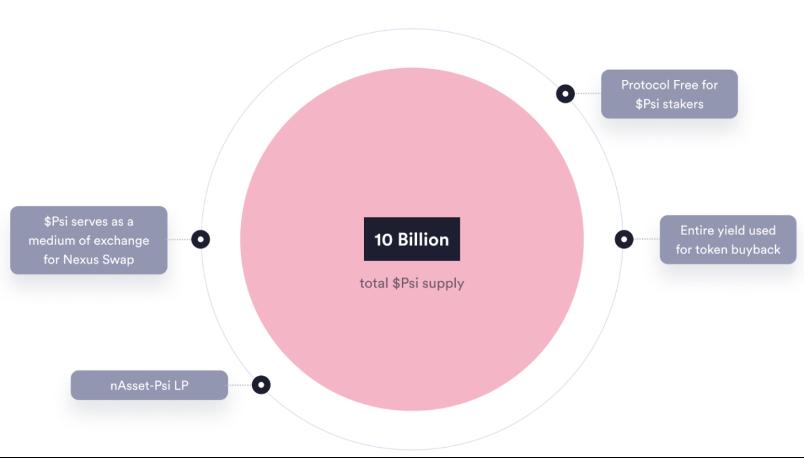
Psi serves as the medium for yield distribution in the Nexus protocol, and the protocol's earnings will be used to purchase Psi in the Psi-UST pool and distribute it to holders of nAssets and Psi, as well as the Nexus community pool.

The total supply of Psi is 10 billion, distributed over 4 years, with the following specific allocation ratios:
- Investors: 15%
- Operating expenses: 3%
- Team and advisors: 20%
- Other airdrops: 1%
- ANC Gov staking airdrop: 11%
- Community fund: 10%
- Psi-UST LP incentives: 10%
- nAsset-Psi LP incentives: 25%
- nAsset reward reserve: 5%
Nexus Project Roadmap
2021 Q4 - 2022 Q1: Protocol's built-in liquidity plan
2022 Q1: Expansion to Ethereum: EthNexus
2022 Q1: Deploy Vexus V2 version, adding Mirror Delta Neutral farming pool + upgrading the original V1 version of bLuna/bETH Anchor farming pool
2022 Q1: Upgrade Nexus LTV management system: add Optimal mode
2022 Q2: Deploy more farming pools
2022 Q3/Q4: Expand farming pools to Polkadot, Solana, and other public chains







